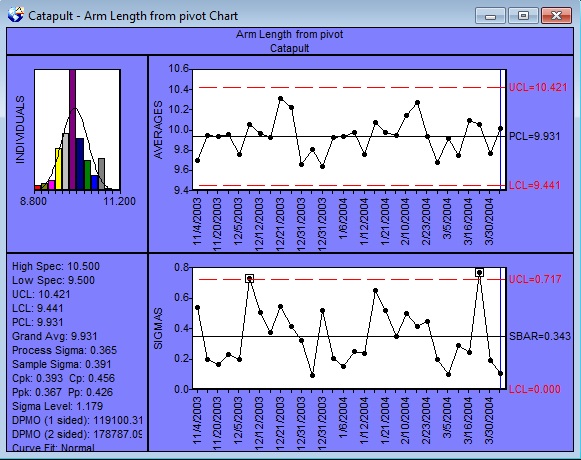Tools
Concepts
Interpretation & Calculations
Histograms, Process Capability
Applications
Key Success Factors for the Implementation of SPC
How to Study Process Capability
SPC to Improve Quality, Reduce Cost
Use Of SPC To Detect Process Manipulation
When to Use an X-bar / S Chart

An X-bar & Sigma Chart with process capability estimates from SPC IV Excel software.
X-bar & Sigma charts are used when you can rationally collect measurements in groups (subgroups). X-Bar / Sigma charts can be easily created using SPC software or (for special use in Gage R&R studies) gage calibration software. Each subgroup represents a "snapshot" of the process at a given point in time. The x-axes are time based, so that the charts show a history of the process. For this reason, you must have data that is time-ordered, that is, entered in the sequence from which it was generated. If this is not the case, then trends or shifts in the process may not be detected, but instead attributed to random (common cause) variation.
For subgroup sizes greater than ten, always use X-bar charts and S-charts, since the range statistic is a poor estimator of process sigma for large subgroups. In fact, the subgroup sigma is ALWAYS a better estimate of subgroup variation than subgroup range. The popularity of the X-Bar Range chart is only due to its ease of calculation, dating to its use before the advent of computers. For subgroup sizes equal to one, an Individual-X / Moving Range chart can be used, as well as EWMA or Cusum charts.
X-bar Charts are efficient at detecting relatively large shifts in the process average, typically shifts of +-1.5 sigma or larger. The larger the subgroup, the more sensitive the X-bar and S-charts will be to shifts, providing a rational subgroup can be formed. For more sensitivity to smaller process shifts, use an EWMA or Cusum chart.
See also:
Interpreting an X-Bar / Sigma Chart
Learn more about the SPC principles and tools for process improvement in Statistical Process Control Demystified (2011, McGraw-Hill) by Paul Keller, in his online SPC Concepts short course (only $39), or his online SPC certification course ($350) or online Green Belt certification course ($499).




